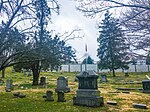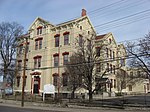Harriet Beecher Stowe House (Cincinnati, Ohio)
AC with 0 elementsBiographical museums in OhioCincinnati Local Historic LandmarksHarriet Beecher StoweHistoric house museums in Ohio ... and 10 more
Homes of American writersHouses in CincinnatiHouses on the National Register of Historic Places in OhioHouses on the Underground RailroadLiterary museums in the United StatesMuseums in CincinnatiNational Register of Historic Places in CincinnatiOhio History ConnectionWalnut Hills, CincinnatiWomen's museums in the United States

The Harriet Beecher Stowe House is a historic home in Cincinnati, Ohio which was once the residence of influential antislavery author Harriet Beecher Stowe, author of the 1852 novel Uncle Tom's Cabin.
Excerpt from the Wikipedia article Harriet Beecher Stowe House (Cincinnati, Ohio) (License: CC BY-SA 3.0, Authors, Images).Harriet Beecher Stowe House (Cincinnati, Ohio)
Foraker Avenue, Cincinnati Walnut Hills
Geographical coordinates (GPS) Address Nearby Places Show on map
Geographical coordinates (GPS)
| Latitude | Longitude |
|---|---|
| N 39.133022222222 ° | E -84.487658333333 ° |
Address
Foraker Avenue 921
45206 Cincinnati, Walnut Hills
Ohio, United States
Open on Google Maps







